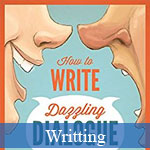 Here you can find the information about the definition of a dialogue, its types, and ways of writing. Good prompts for dialogue writing are also available.
Here you can find the information about the definition of a dialogue, its types, and ways of writing. Good prompts for dialogue writing are also available.
What is a dialogue? According to Wikipedia, it is a piece of written or spoken communication between two or more people, and its literary and theatrical expression. Hence, many people who want to become professional writers have different troubles with conversation writing.
- Demo
- Enlarge
- Reload
- New window
Free iPage Web Hosting for First Year NOW
If you're still looking for a reliable web host provider with affordable rates, why you don't take a little of time to try iPage, only with $1.89/month, included $500+ Free Extra Credits for the payment of 24 months ($45)?
Over 1,000,000+ existisng customers can not be wrong, definitely you're not, too! More important, when you register the web hosting at iPage through our link, we're going to be happy for resending a full refund to you. That's awesome! You should try iPage web hosting for FREE now! And contact us for anything you need to know about iPage.
A dialogue as a writing tool has several basic functions:
- Mood. Conversations help to create a general mood of the whole creation.
- Characters. Interlocutions help to show characters from different sides, show all their advantages and disadvantages, their feelings and emotions concerning various events, etc.
- Setting. Conversational interactions can help to understand the setting of the described situation.
- Development of the plot. Interlocutions give the material for movement of the plot, they manifest escalation of the conflict, which is the engine of every literature creation.
This tool is very useful for text creation; therefore, we are glad to present the collection of dialogue creating prompts from professional essay writers.
Types of Dialogues
Literature scholars and professional authors distinguish many kinds of literary conversations. Their four main types are:
- Directed dialogue. It is the simplest kind of interlocution that can be used in literary writing. The interaction happens directly between two people: character A and character B.
- Misdirected dialogue. It looks more like natural communication between two people because the participants donât answer direct questions, the tone and manner of communication may vary, the third person may interrupt their talk, etc.
- Modulated conversation. This type of dialogue is a good basis for other important details, which can increase the tension of narration or reveal some of its key aspects. Such a type of conversation between two characters may gradually slow into retrospection, as a way to develop the plot, or observation, etc.
- Interpolated conversation. This type of interlocution is used as an insertion. It means that the dialogue itself can be interrupted with narrations to explain and interpret some information, which is not given in the interaction directly because of some reasons.
Different Prompts for Interlocution Creation
It seems easy to think out the interaction between two characters of the novel. However, many unfledged authors have some difficulties with conversation writing. If you are one of them, we can give you several pieces of advice to solve such a problem. They are as follows:
- Make it natural. Just try to listen to how real people are talking and try to recreate such a natural manner of communication in the necessary dialogue. Such method will make the characters of your future novel more vivid.
- Mind the movement of the interaction. You have already learned that there are different types of dialogues and all of them have various movements - direct or indirect. Thus, it is very important to remember about this movement and the chosen type of interaction while writing. Otherwise, the whole scene of this interlocution will be messed up.
- Create the first draft. Drafting is extremely important in the writing process in general and especially in interlocution creation. It is so because the author should not only think through the information, which will be given in the interaction, but also choose the general manner and tone of speaking for each participant of the interlocution.
- Make the map of the relationship between all characters. Such a map may be a nice reminder about the plot in general and certain characters in particular. Thus, you can use it to define the necessary tone and manner of interlocution between certain two or more personages of the novel.
- Create the second draft. Let us imagine that you have already written the necessary dialogues, but then you decide to change the plot. In this case, you have to overview the relationships between characters and consequently rewrite all or several interlocutions. It is a normal situation, donât give up.
- Try to come up with a short version. Remember that brevity is the sister of talent. Certainly, each author has his or her own style of text creation, which is reflected in the interaction writing as well, but if there is a real opportunity to shorten the dialogue without any sacrifice of meaning, try to do it to avoid readersâ getting bored.
- Intersperse interactions with action scenes. Interlocutions must be interspersed with narrations, different descriptions (if necessary), flashbacks, etc. On the other hand, it is also important to add diverse action scenes to make the plot more dynamic and reveal characters from different sides.
So, using all information given above, you will be able to build a captivating story or a novel, which becomes your first step to success. Maybe you will become the author known all over the world, who knows? Just have a regular practice and do something that you like. If you know that you want to become a novelist, it is better to practice every day. Following our recommendations, you will not have so many troubles with dialogue creation.
Author
 Phong Thai is a Web Developer, Web Coder for 20 years with PHP, JavaScript, CSS. He is the creator of JavaScriptBank.com - provide thousands of free JavaScript code examples, web development tips and tricks, helpful blogging guides.
Phong Thai is a Web Developer, Web Coder for 20 years with PHP, JavaScript, CSS. He is the creator of JavaScriptBank.com - provide thousands of free JavaScript code examples, web development tips and tricks, helpful blogging guides.
Follow him on twitter@js_bank or connect with him on facebook@jsbank if you want. His websites for your knowledge: javascriptON.com, inOneSec.com, www.gomymobi.com
- Sent (0)
- New
Save up to 630$ when buy new iPhone 15
GateIO.gomymobi.com
Free Airdrops to Claim, Share Up to $150,000 per Project
https://tooly.win
Open tool hub for free to use by any one for every one with hundreds of tools
chatGPTaz.com, chatGPT4.win, chatGPT2.fun, re-chatGPT.com
Talk to ChatGPT by your mother language
Dall-E-OpenAI.com
Generate creative images automatically with AI
AIVideo-App.com
Render creative video automatically with AI






 17/05/2017
17/05/2017 0
0
